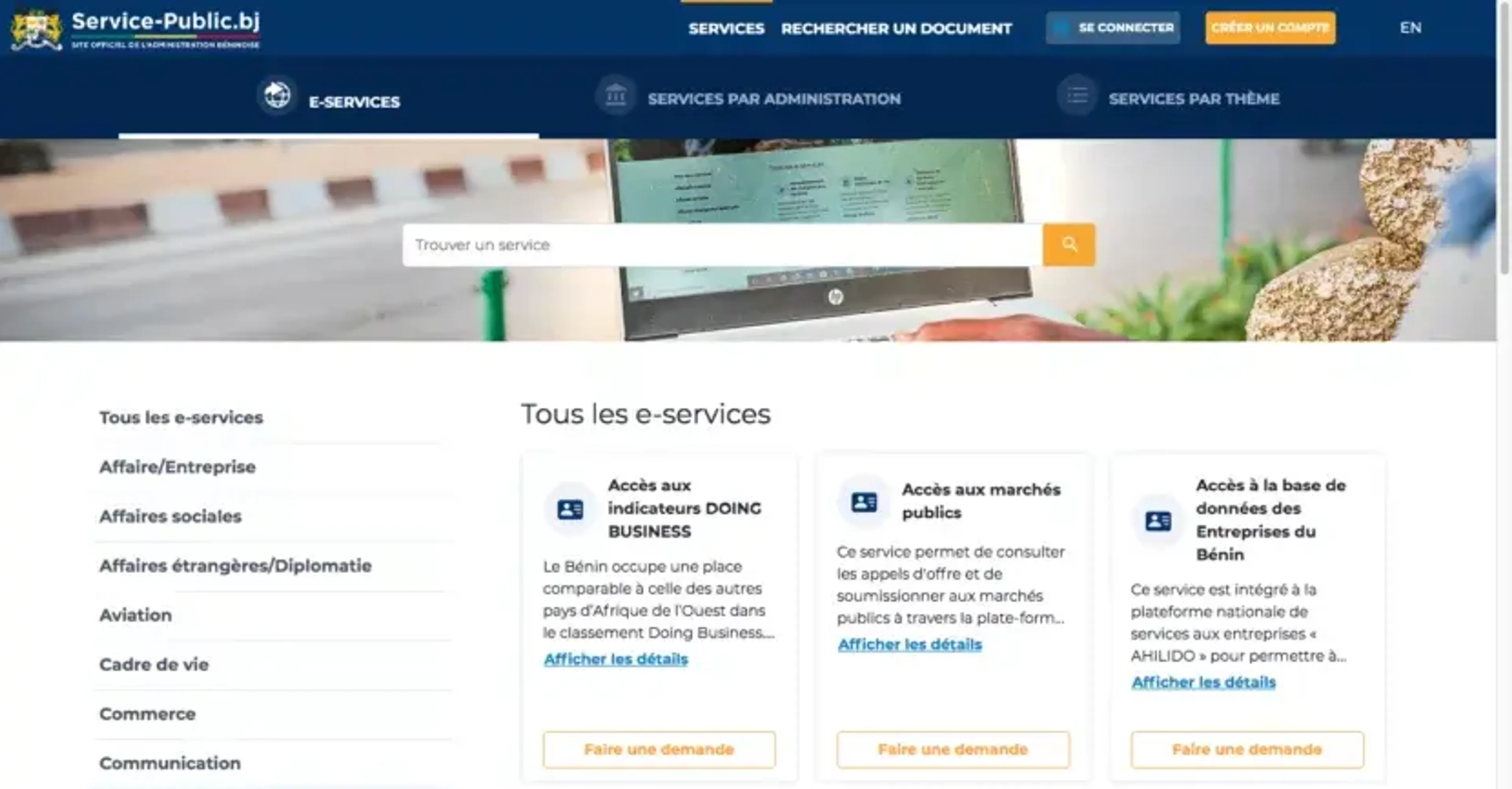
Claire Bedoui
Director
This article was originally published by GovInsider.

Benin and Mongolia do not at first appear to have many similarities. One is a relatively small, but densely populated country in West Africa. The other is a large, but sparsely populated country in Central Asia. Yet, citizens in both countries have something in common: since 2020 they’ve had access to hundreds of new public services online.
In March 2020, the Government of Benin launched its national public services portal called service-public.bj which provides access to 70 transactional services like passport or building permit applications. It also delivers clear and coherent guidance on over 500 other public services. Soon after this, Benin launched an e-learning platform for public university students, and a website with the results of national public exams.
Meanwhile in Mongolia, the Government launched a platform available both online and through a smartphone app called e-Mongolia. E-Mongolia gives citizens access to the 181 most in-demand government services. Five months after its launch, e-Mongolia had been used by 700,000 people – that’s over 35 per cent of its adult population.
These new online services came at a perfect time, as governments tried to limit in-person interactions with citizens during the covid-19 crisis. This article looks at how these achievements were made possible, as well as the common features behind these two countries’ digital transformation success stories.
In both countries, political leaders have put the digital transformation of public services at the core of their agendas. Patrice Talon, President of Benin since 2016, made this clear in his five-year action plan ‘Bénin Révélé’. He also names connectivity, digital literacy and smart administration as key development areas.
The same applies in Mongolia. The 40-year-old and recently appointed Prime Minister Luvsannamsrain Oyun-Erdene has affirmed that building a digital nation is currently the country’s top priority.
But strong political support on its own is not enough. In Benin and Mongolia, much of the credit should be given to the women in charge of driving the digital transformation of their respective governments: Aurélie Adam Soulé Zoumarou and Bolor-Erdene Battsengel.
Aurélie Adam Soulé Zoumarou is the Minister of Digital Affairs and Digitalisation of Benin. She was appointed to this role by President Patrice Talon in 2017. Since then, she has led a wide range of programmes covering digital infrastructures, smart administration and support for technology start-up companies.
Bolor-Erdene Battsengels was appointed the Chairwoman of Mongolia’s Communications and Information Technology Authority (CITA) in July 2020. At 27 years old, she is the youngest person and first female to hold this position. For her first three months in CITA, she oversaw the implementation of the e-Mongolia platform.
The digital transformation of the governments of Benin and Mongolia also rely on an efficient governance model, where a central digital agency is empowered to drive change.
The Information Services and Systems Agency of Benin (ASSI) is the country’s central organisation in charge of executing flagship projects in digital government. It provides strategic and operational assistance to all government organisations, and ensures the coherence of information systems and services across public administration. The ASSI is directly under the direct supervision of the Presidency.
In Mongolia, the Communications and Information Technology Authority (CITA) is in charge of both ICT policy making and its implementation and it is responsible for the development of e-Mongolia. The fact CITA is placed under the authority of the Prime Minister gives it great legitimacy in leading cross-government projects.
In both countries, that direct link to government decision-makers has proven paramount to the success of these agencies, reaffirming their authority as well as allowing for swift transformation when necessary.
Benin and Mongolia did not wait for the covid-19 crisis to kickstart their digital transformation. The speed at which they were able to launch services in 2020 reflects the ground work they laid in previous years. Likewise, the early adoption of digital services by citizens could not have been possible without the significant efforts demonstrated by both countries in terms of infrastructure development in the past few years.
Since 2016, 2,000 kilometres of optical fibre has been installed across Benin which has helped the country more than double its internet coverage. And in order to reach citizens from all communities, they have set up a network of over 40 Community Digital Points, which are effectively public spaces where citizens can access computers and get online.
Alongside connectivity infrastructure, Benin and Mongolia have invested in digital infrastructure. It is worth mentioning that both countries have based their data infrastructure on the open source data exchange solution X-Road.
Mongolia started to use the X-Road model as early as 2016 to connect the information systems of all its ministries. But it took time to implement the system, and encourage data sharing across public administrations.
Both Benin and Mongolia have understood the value of working hand-in-hand with the civil society, and the private sector. In October 2020 – prior to the development of a national e-payment platform – the ASSI organised a discovery workshop with various players in the financial sector. It welcomed comments and ideas from private actors to inform the development and implementation of the platform.
The Government of Benin was also receptive to help from private sector and civil society actors when the covid-19 crisis started. Start-up companies, SMEs, large corporates, academics, NGOs and government agencies gathered in 2020 to create ‘Taskforce INNOV covid-19’ and brainstorm on innovative solutions to the challenges caused by the crisis.
In Mongolia, CITA engaged with citizens to prioritise the services to include in the e-Mongolia platform. They conducted a survey, available both online and on paper. They also tracked the time citizens spent queuing to access public services. They kept engaging with citizens while developing the platform, to make sure all information was clear, and that services were easy to use.
In order to go fast, and keep momentum, CITA outsourced the development of the platform. However, they created a small project coordination unit in-house, to hold service providers accountable, and coordinate all stakeholders from the 28 government organisations involved.
Benin and Mongolia made tremendous progress in government digital transformation last year. But that’s the result of a long, slow process that started years before. They’d already laid the essential foundations they could build on, including recruiting and empowering committed leaders, putting the right digital governance in place, investing in digital infrastructure, and creating channels to engage with civil society and private sector actors.
Compared with many countries, the covid-19 crisis has not had such a significant impact on the digital transformation plans of Benin and Mongolia because they already knew where they were heading – the pandemic only confirmed they were going the right way.

Director